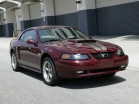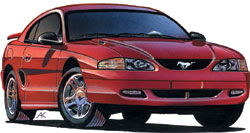Test drive Ford Mustang 1998 - 2004 compartment
Steel muscles- Ford Mustang
Among other muscular cars of the sixties, Ford Mustang stands apart. Firstly, he was originally conceived as a sports car of modest (according to American concepts) dimensions, and did not appear as a result of crossing a powerful engine with a two-door family sedan. Secondly, in the first year, Mustang was sold in the amount of 419,000 copies, which surpassed the volume of sale for the same period of all muscular cars combined. Thirdly, for a long time a basic power unit for the car was a motor of 120 horses, against the background of at least 250-horsepower installations of competitors, which looked unconvincing.The idea to offer the Americans a compact, dynamic and stylish car occurred to the Vice President of the Ford Motor Corporation Lee Jacock in 1961. Then one similar model was produced in the United States - Chevrolet Corvette with a Fiberglass body, which had to compete with the whole army of Europeans. Yakockka conceived a four -seater with two doors, four and a half meters long, weighing about 1100 kg, and, most importantly, a vacation price not exceeding $ 2,500. Many months have gone to all kinds of meetings, meetings, collective discussions and sociological studies, and only in September 1962, funding was allocated for the project. The development was sharply accelerated in the fall of 1963, when a real boom in muscular cars erupted, and eventually took exactly one and a half years.
The appearance of the car, designers David Ash and Joe Oros tried to withstand in the European style. In profile, a car with its long hood of a characteristic shape and a short trunk looked great on the American fighter of the R-51 Mustang from the Second World War, which made a decisive contribution to the victory over the Japanese in the battles for the Pacific Ocean. Therefore, the car was called a mustang, although at first they wanted to appropriate him to the cat's name Cougar. Almost simultaneously, the public was presented to the public with the 271-horsepower V8 engine, which was based on the chassis almost ready for launching into a series. To reduce the cost of the machine, the designers went to borrow a chassis, as well as some other components from the Falcon sedan.
The first Mustang left the conveyor on the morning of March 9, 1964, and the full -scale advertising campaign started at 9:30 April 16, when the ABC, NBC and CBS - commercials were held on three leading American television networks. A day later, the World Exhibition opened in New York, where the official premiere of the Ford Mustang model took place. The car was shown in two versions - as a two -door sedan and a convertible, at the same time announced the basic price - $ 2,368. The market reacted with unheard of enthusiasm: already in the first hours of the Ford exhibition received more than 22,000 orders for the car. By the end of 1964, 263,434 cars were sold, and Mustang stepped over the millionth mark in two years. The head enterprise in Dirborne, which worked with full load and still failed to satisfy the excitement demand, urgently received reinforcements in the form of factories in San Jose and Metute, converted for the production of a newfangled machine. Thus, the Fords literally crushed competitors from Plymouth, who did not doubt for a minute that it was their Barracuda that would be a muscular number one in the United States. The key to the stunning success of the machine was a huge list of custom -made equipment, thanks to which one client could order a copy with a modest appearance, a Spartan interior and an unpretentious motor, and the other received a Mustang with a body painted metallic, generously decorated with chromium, with a powerful engine, sports gearbox, and a sports gearbox, leather salon and air conditioning. No wonder one of the advertising slogans sounded like this: we will make Mustang especially for you.
At first, two power units were installed on the car: a row six with a 2.8 -liter working volume and a capacity of 101 liters. p., 164-horsepower V8 Motor with a volume of 4260 cubes and 4.7-liter V-shaped eight, developing 210 horsepower. Any of the listed engines could work in tandem with a three- or four-speed manual gearbox or an automatic Cruise-O-Matic. However, modest dynamic indicators did not allow Mustang to be called the proud name of the muscular car. Outwardly, he approached this definition of one hundred percent, but in semi -legal, and often completely illegal races, very common in America of the sixties, he performed unconvincingly. The situation changed already in June 1964, when a Mustang with a Fastback body (a distinguishing roll roof) was on sale, and a 271-horsepower version of the 4.7-liter motor made his debut with it.
Europeans accepted the car with no less enthusiasm than the Americans themselves. The car conquered the inhabitants of the Old World with a stylish design, powerful motors and an acceptable price. Mustang took the third place in the European competition of 1965, and in the same 1965 Roy Pirpoint won the gold of the British British Circus Cars Championship at the wheel of a specially prepared car.
Next, sports modifications appeared, developed jointly with the famous company Carroll Shelby, whose efforts were created by the legendary Cobra. In the performance of Shelby GT-350, the car engine produced 306 liters. p., and in the special racing Shelby GT-350R-all 360. Only in the 1966 model year, the PAXTON brand is also installed on the GT-350, which allowed to increase the power of certain revolutions to 420-430 horsepower, upon reaching the engine. All huts prepared on Shelby were white fastema, with a minimum of interior decoration, even without a rear seat, ready to go to the track at least now. By order of the well -known rental company, Hertz was assembled a batch of cars performed by the GT -350N - they were submitted to short -term lease to everyone to participate in real races. In April 1965, ordinary buyers were offered a GT package, which included: a configured suspension, a more acute steering, disc brake mechanisms of all wheels, a double exhaust system and a special coloring of the body. By 1966, the individualization of Mustangs reached new heights - according to advertising booklets, the interior of the machine in style and color scheme could be decorated in one of 34 options (!).
Meanwhile, the rivals did not consider Ford Mustang a full-fledged muscular car due to its small size. For sports machines of this class, they came up with a special term - Pony Cars, pony cars. In this nickname, a mockery of Mustang was hidden: firstly, his proud name was twisted, and secondly, it was emphasized that, by the standards of a true freedom-loving American, Mustang was still small, thirdly, he also lacks power and speed. True, the last statement from year to year lost its relevance. The other thing is worse - the Fords went on the occasion of constant jokes over the dimensions of the car, and decided to grow it. As it turned out later, this was a fatal mistake.
By the 1967 model year, Mustang in length and height added several centimeters. Accordingly, the transformation has undergone the majority of body panels. Fastback has especially changed, in which the rear window and trunk lid were now located on the same line. Eight power units were offered to choose from - from an in -line six with a volume of 3.3 liters and a capacity of 115 liters. With. to a new V8 volume of 7014 cubic meters. See, developing 355 horses. Installing a seven -liter engine (only the coolest Mustang - Shelby GT -500) became possible as a result of lengthening the motor compartment. Now the car could compete on equal terms with the main muscular star - Chevrolet Camaro SS396. By the way, in 1967, Carroll Shelby transferred all the rights to the production of Mustangs with the HELBY prefix of the Ford Motor corporation, refusing to participate in the preparation of subsequent sports versions of the machine. Of great interest is another option of that year, the hydromechanical transmission of the FMX, shifts in which could be carried out both automatically and manually (for some reason it is believed that such boxes are the achievement of technological progress of recent years).
In 1968, changes occurred in the engine line - two new eight -cylinder engines appeared. From that moment, the buyer of Mustang was faced with the difficult choice of ten power plants with volumes 3.3, 4.7, 5.0, 6.4 and 7.0 liters, with the following gradations in power: 115, 120, 195, 230, 250, 271, 320, 325, 335 and 390 Horse power. On April 1, Shelby GT-500KR with a seven-liter RAM AIR 428 Cobra Jet, with a largest area and a special air fence, which with an official power of 325 liters, was on sale. With. Easily developed 410 liters. With. Up to 97 km/h GT-500KR accelerated in 5.4 seconds, and the maximum speed of the car exceeded 250 km/h. However, the departure from the classic appearance of the 1964 model negatively affected sales volumes: if 620,000 mustangs were sold in 1966, then in 1968 it was already 320,000. But this figure was ten times exceeded the result of any other muscular car.
By the 1969 model year, Ford Mustang suffered a second, this time capital modernization. With the previous wheelbase, the length of the machine increased by 10 cm, and the mass is 60 kg; New versions appeared in the line - cheap E, luxurious Grande and Mach 1 C 335 -horsepower engine. In turn, Mach 1, designed for super -popular races in a straight line at a quarter of a mile, was produced in three performances. The standard equipment of the most charged Mach 1 Drag Pack included even a self -locking inter -long differential of the rear axle.
But the most of interest were the modifications of the BOSS series, which Ford released in order to homologue of racing machines. Boss President Ford Motor Co. Simona Knudson was the first of the employees was the stylist Larry Shinod, who worked for a long time at General Motors, where he was responsible for the design of the Chevrolet Corvette model. At the end of the sixties tire, he moved to Ford to a special department, which was developing the appearance of racing mustangs. The younger Mustang Boss 302 (the numbers correspond to the working volume of the engine in cubic inch) with a 290-horsepower engine intended to combat Chevrolet Camaro Z28 in the Races of the Trans Am series, held on oval tracks. His older brother, Mustang Boss 429, was created to participate in the NASCAR series. The machine was equipped with an eight -cylinder engine with a capacity of 375 liters. p., which developed a torque of 611 Nm at 3400 rpm, many details of which were made of light alloys. The installation of a large motor caused an audit of the front suspension, as a result of which the location of the shock absorbers changed, and the double transverse levers were lowered by 25 mm. Boss 429 also received a sports four -speed transmission, oil radiator and the best interior. Outwardly, the car was distinguished by a hood with a huge air intake, spoilers and dilated wheels. However, despite the impressive data, in reality, the car was not the best adapted for street racing: the lack of torque on the bottoms did not allow the starts to win from the place, and due to the improper setting of the gas distribution mechanism, the engine sour after 4,500 rpm instead of design 6000. But on winding roads, Boss 429 did not know equal.
The peak in a short history of muscular cars came in 1969. Then the US government adopted a number of laws that tightened the requirements for the average fuel consumption, the toxicity of the exhaust and passive safety. As a result, not only the further increase in capacities and speeds became impossible, but on the contrary, they began to decline steadily. In the 1970 model year, Ford took a waiting position, and left the Mustang model almost untouched.
In 1971, the car has grown once again, with almost 50 kg with almost 50 kg. The new machine finally lost its originality and harmony, for which connoisseurs are so fond of original Mustangs, and for no one has no secret that Mustang is turning into another clumsy comfortable compartment. The family was headed by modifications with a 429 Cobra Jet Ram Air engine with a capacity of 370-375 liters. With. and versions of Mach 1 and Boss 351 with a 330-horsepower engine. In total, 150,000 cars were produced in the 1971 model year, and the rate of decline in sales was preserved.
With the consequences of environmental laws that entered into force, buyers first encountered in September 1971, when dealers received cars of the 1972 model year. All muscular cars lost up to 30% of their horsepower, and the sunset of the short era of capacity race began as rapidly as it came seven years before. He did not escape the sad fate of Mustang - in fact, he stopped being a sports car, and only the 275 -horsepower version of Mach 1 reminded of former greatness. The production of the BOSS series modifications has stopped.
All who survived in 1971 were destroyed in 1972. The government again legally limited the permissible level of excessive toxicity. In order to fit into the norms, corporations -manufacturers of cars again used a proven and cheap way - reducing the degrees of compression of the engines. For example, the V8 Motor with a volume of 5751 cubes installed on Mustang now developed a miserable 156 forces, and this despite the fact that it was the most powerful power unit. The weakest, six -cylinder, with difficulty issued 95 liters. S., and with the same difficulty accelerated a heavy car.
In the 1974 model year, a completely new Mustang II started, an ordinary two -door sedan, which in no way claimed sports. Four years later, the angular Mustang III appeared, with which Ford tried to get into the sector of sports cars again. In the late eighties, powerful versions of SVO, Saleen and Cobra were prepared, but by that time the reputation of the car was pretty tinerered due to reliability problems. Finally, from the fall of 1993 to this day, Mustang IV is produced, stylized under the 1964 car. With the last Mustang, an embarrassment happened, indicative, by the way, in many respects. In 1998, she debuted the 320-horsepower modification of SVT, promoted as a symbol of the revival of the romance of the distant sixties. However, it suddenly became clear, and later confirmed by the results of the technical examination that the SVT motor does not develop the declared capacity, and in the summer of 1999 the production of this modification had to be turned.
Most likely, it is simply unfair, and it is pointless (with the exception of the commercial side of the matter) to try to revive what belongs to history. It is much more reasonable to create without looking back at the past, inhaling life into new names, so that they should be said to their descendants later. And the descendants will not forget anything and they will appreciate everything. So, Ford Mustang, the hero of our story today, the international jury of the competition, was included in the list of 27 best cars of the twentieth century. And even if he did not get victory, but he was honored to be among the best of the best. Thirty-six years ago, Mustang proved that a swing car, beautiful, powerful and speedable, is not necessarily doomed to serve as a toy for a limited circle of thicknesses. A dream can become a reality.
A source: Wheel magazine [No. 2/2000]





